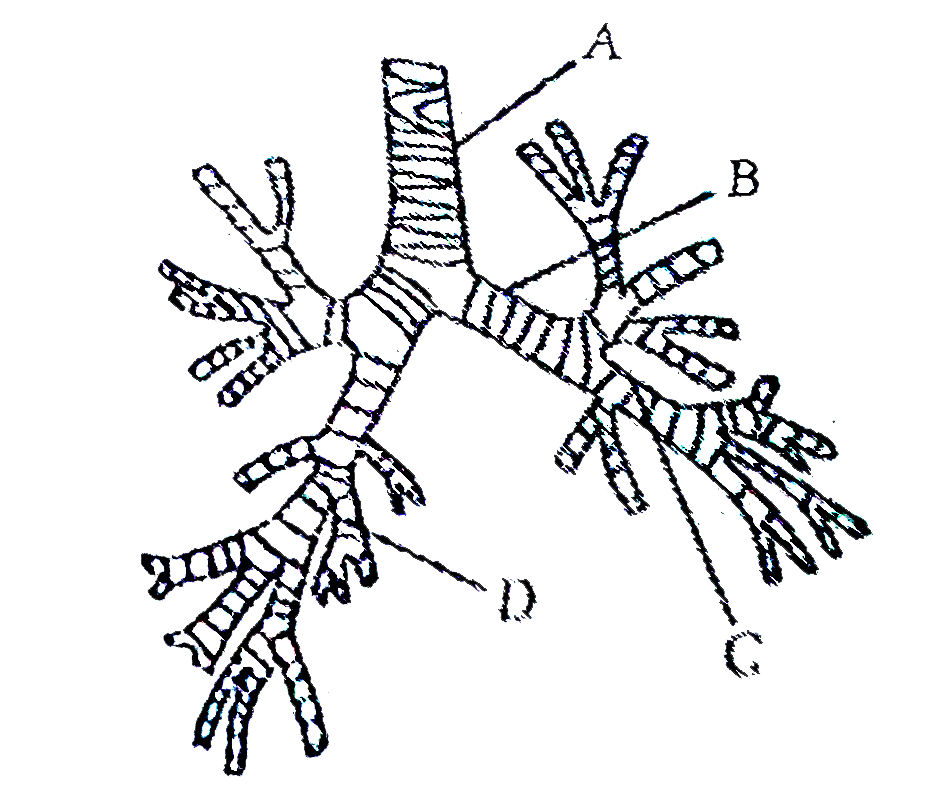In pseudostratified columnar epithelium, the
I. epithelium appears as multilayered.
II. cells are of more than one type .
III. longer cells extend upto the free surface, while the short cells do not reach the free surface.
IV. membrane is multilayered, but appears single layered.
Choose the option with the correct statements.
I, II and III
I and III
II and IV
All of these
The correct Answer is:A
Step by step video, text & image solution for In pseudostratified columnar epithelium, the I. epithelium appears as multilayered. II. cells are of more than one type . III. longer cells extend upto the free surface, while the short cells do not reach the free surface. IV. membrane is multilayered, but appears single layered. Choose the option with the correct statements. by Biology experts to help you in doubts & scoring excellent marks in Class 12 exams.
Updated on:21/07/2023Topper's Solved these Questions
- ANIMAL TISSUES BOOK - ARIHANT NEETCHAPTER - ANIMAL TISSUES EXERCISE - CHANPTER EXERCISES (MEDICAL ENTRANCES GALLERY)(COLLECTION OF QUESTIONS ASKED IN NEET & VARIOUS MEDICAL ENTRANCE EXAMS)
63 Videos
- ANIMAL TISSUES BOOK - ARIHANT NEETCHAPTER - ANIMAL TISSUES EXERCISE - CHANPTER EXERCISES (TAKING IT TOGETHER)(ASSORTED QUESTIONS OF THE CHOPTER FOR ADVANCED LEVEL PROCTICE)
126 Videos
- ANIMAL HUSBANDRYBOOK - ARIHANT NEETCHAPTER - ANIMAL HUSBANDRYEXERCISE - CHAPTER EXERCISES (Medical entrances gallery) Collection of questions asked in NEET & Various Entrance Exams
18 Videos
- ANIMALIA -I (LOWER INVERTEBRATES)BOOK - ARIHANT NEETCHAPTER - ANIMALIA -I (LOWER INVERTEBRATES)EXERCISE - CHAPTER EXERCISES (Taking it together) medical entrances gallery (Collection of Questions Asked in NEET & in various Entrance Exams))
68 Videos
Similar Questions
Study the following diagram and consider the statements following in regard to the labels .

I. A is lined by pseudostratified ciliated columnar epithelium bearing glandular cells and cartilaginous ring.
II. B is the part of lung where major exchange of gases takes place.
III. C decreases both in diameter and thickness as it gets take place.
IV. D is part of lung where exchange of gases do not take place.
Choose the correct set of statements.
View SolutionRead the following statements:
i. Membrane-bounded inclusion bodies are not found in prokaryotic cells.
ii. Ribosomes are the site of protein synthesis.
iii. Pili are the surface of the bacteria which may play a role in motility .
iv. The cell membrane of prokaryotes is structurally similar to the eukaryotes.
Choose the option with the correct statements.
View Solution
Knowledge Check
The layer of cells forming tissue that appears to be multilayered but actually some of the cells extend from the basement membrane to the surface is
ASimple columnar epitheliumBPseudostratified epitheliumCStratified columnar epitheliumDStratified cuboidal epitheliumNeurons
I. are considered as the shortest cells of the body.
II. arise in the embryo from neuroblast cells.
III. contain cyton, which occur in white matter of central nervous system.
IV. are without centrosorne.
Choose the option with the correct statementsAI and IIBII and IVCIII and IVDNone of theseRed blood cells
I. of amphibians are largest among vertebrates.
II. of mammals are smallest among vertebrates.
III. of mammals are biconc,we and nucleated.
IV. are seen in all invertebrates and vertebrates.
Choose the option with the correct statements.Al, II and IIIBI and IICIII and IVDII and IV
Epithelium with single layer of tall and slender cells with microvilli on their free surface occurs in
View SolutionWhich of the following statements is/are correct?
I. Striped muscles are in the form of bundles of cells.
II. The Pal muscle fibres, which are called fasciculi.
III. Skeletal muscles form the largest tissue in the body.
IV. Cardiac muscles in the embryo are originated from mesenchyma cell.
Choose the option with the correct statement(s).
View SolutionIn meiosis,
I. every chromosome behaves independently,
II. Homologous chromosomes show pairing.
III. Found in somatic cells.
IV. Crossing over occurs.
Choose the option with correct statement(s).
View SolutionRespiratory system of cockroach
I. consists of tracheae, tracheoles and spiracles.
II. are coordinates and regulated by nerve centres in thoracic genglia which are stimulated by low O2 and higher CO2 concentration in tissue fluids.
III. contains mainly four types of cells trophocytes, mycetocytes, oenocytes and urate cells.
IV. is open or lacunar type.
Choose the option for the correct statements.
View SolutionWhich of the following statement are incorrect about receptor proteins?
I.Majority of receptor proteins are embedded in the cell membranes
II.The active site of receptor proteins opens on the inside region of the cell
III.Chemical messengers are received at the binding sites of receptor proteins
IV.Shape of receptor does not change during attachment of messenger
choose the option with all incorrect statements
View Solution
